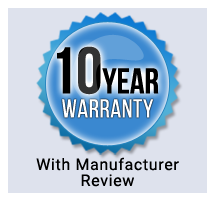Style and strength: We all want it and we can all have it when it comes to our roofs. Metal roofs are the newest fad in roofing, in part due to their longevity and durability, but also because of the unique and stylish appearance that you can only get from the use of metal as a material for roofing. The striking appearance of metal roofs is probably the major reason why they are becoming so popular. With a choice of multiple different styles, textures and colors available, you’ll be able to enhance the style of your house and help make it withstand the elements better than ever. Metal roofs offer maximum resistance when it comes to withstanding ice storms, fires, hurricane winds and even earthquakes.
While a regular asphalt or old fashioned tile or slate roofing can need repairing or re-installing every 10-15 years, a metal roof, if properly take care of, can last for up to 50 years or even more. Metal roofs are able to withstand just about anything that Mother Nature can throw at them. Compared to other kinds of roofs, there really is no contest when it comes to strength and durability. Most metal roofs come with warranties for up to 30 years, and if you decide to recoat it then perhaps you’ll never need to repair it in your lifetime.
Metal Roof Types
There are several different kinds of metal that are used as roofing materials, and it’s important to know about the unique characteristics and differences between them.
Steel Roofs
The most common kind of metal roof is made from steel. Being one of the most well developed metal industries, steel is a great choice as it offers strength and flexibility, it’s affordable and it is good for any kind of building be it residential, industrial or commercial. Steel roofs are usually made using G galvanized steel, with galvalume steel being used for the sheet metal coils as it’s of a higher quality. Although other (more expensive) kinds of stainless steel are sometimes used on high end developments like commercial buildings, more often than not galvanized steel is the best choice.
Tin Roofs
Tin roofing has quite a long history in the US. Tin smith craftsmen used to do a roaring trade in tin roofs for residential homes for many, many years although they are far less common now. Some are still installed, but tin is nowhere near as durable as other kinds of metal, steel for instance, and needs to be coated regularly in order to preserve their condition and stop them from corroding.
Aluminum Roofs
Probably the longest lasting metal roof material, aluminum can last longer than even the building does sometimes. Aluminum does not get affected or degraded by the natural elements it is exposed to, nor by salt or oxidation. While the paint may fade, the roof will always last.
Copper Roofs
Highly expensive, but offering reliability, beauty and style all in one, copper roofs can be something of a luxury. Unpainted copper has its own natural grace and classical beauty that will never go out of style. Copper is quite similar to aluminum because it is very long lasting though the color will slowly change, but even then it doesn’t matter because the ‘aged copper’ look is very much sought after. Because of its prohibitive cost, copper is rarely used on residential homes. Only the most exclusive homes will have copper roofs installed. The reason for the cost is that copper itself is a very expensive material, and the installation process is also a very difficult process, requiring lots of soldering and mechanical attachment. If you opt for copper shingles, then the process for installing them is the same as for aluminum and steel roofs, therefore the cost will be quite a lot cheaper.
Zinc Roofs
Zinc roofs are not that much different from copper roofs overall. Both are expensive and both are extremely long lasting. However, copper is widely preferred as it is more aesthetically pleasing.
Iron roofs
The last common metal roofing material is iron. Iron roofs are not common at all, and offer much the same qualities as steel roofs do.
Cleaning
The first and most important step for metal roof maintenance is to keep it clean. Cleaning will help to reduce the build up of algae, mildew and mold, and will go a long way towards ensuring that the roof remains in the best possible condition.
Step by Step Roof Cleaning:
• First of all you need to assess the roof’s condition. An older roof that is worn and damaged will need to be cleaned much more thoroughly and more carefully than a newer roof. • Make sure that it is safe to work on your roof. Ascertain beforehand that you can reach all the places on the roof where it will be necessary to go. If you feel it is required, wear a harness or some kind of safety rope • Use a wire brush to scratch away any corrosion, rust or excess paintwork before you start cleaning. For harder objects, you can use a putty knife, but be careful not to scratch the paintwork where there is no excess paint as this could damage the roof sheets. • Use a TriSodium Phosphate solution (TSP) and mix it with water, approximately half a cup to one gallon of solution. Bring the solution up to the roof in a large size bucket and apply it to any dirty areas, especially where there is mildew or mold. Then you need to take a soft brush and scrub the area until it’s clean. If the roof is especially dirty it might be a good idea to scrub the whole roof down. After scrubbing the roof, rinse the washed areas with buckets of water, making sure that no TSP residue is left over. Once the roof is dry, you can evaluate its condition again. • The final step may or may not be required, usually depending on how old and dirty the roof is. If you think it is necessary, use a power washer on the roof. This is the best possible way to clean off the hard to remove, ground in dirt. Begin at the top (ridge) of the roof and work downwards, as this allows for the debris and grime to be washed away as you clean. Try to keep the nozzle of your power washer at the same distance from the roof as you gradually work your way down spraying it. If necessary, add a little detergent to the water, but not too much because you’ll want to avoid suds which can leave a sticky film on the roof. • Finally, rinse the roof down again and allow it to dry. The last step after cleaning is to re-apply a coating of protective metal roof paint.
Maintaining Your Metal Roof
Metal roofs are a lot less work than other kinds of roofs when it comes to maintenance, and can provide your home with protection for generations if taken care of properly. All metal roofs will come with a protective coating; however, this coating may not last very long. Therefore, the first and best step you will ever make in protective maintenance of your metal roof is to cover it with a new, reliable protective coating. Several different choices of metal roof coating are available and they include polymeric and asphalt coatings.
Most metal roofs are constructed using long metal sheets or with metal tiles. It doesn’t matter what kind of material is used on your roof, there is going to be a danger that, at every intersection where the tiles or sheets are overlapped, leaks can occur. Metal roofs will usually wear fastest around the ridge and valley of the roof, as well as around the fascia board. This can be avoided with proper maintenance.
What’s Necessary
The majority of metal roofs are protected by being either aluminized or galvanized, or else they are painted with galvalume protective coating. Each of these materials is pretty much maintenance free, although regular cleaning is a necessity. However, it is better to add your own, high-performance protective coating if you want true piece of mind.
The majority of metal roofs are protected by being either aluminized or galvanized, or else they are painted with galvalume protective coating. Each of these materials is pretty much maintenance free, although regular cleaning is a necessity. However, it is better to add your own, high-performance protective coating if you want true piece of mind.
Metal Roof Sealants
There are many great and innovative new solutions for metal roof sealing. Traditionally used ashphaultic sealants have been outperformed when compared to newer products such as the micro sealant called EternaBond. This new product comes as a large roll of sticky tape and can be applied easily by anyone, even somebody with no experience. The EternaBond tape offers great resistance to temperature extremes and inclement weather, and it’s a good fix for leakages too. However, it’s worthwhile to know that while a sealant such as this is great for patch up jobs, employing preventative measures such as a PVDF coating means that it’s unlikely you will ever need to use a sealant.
Things to Know
Before undertaking any maintenance we recommend that you consult a roofing expert about all the safety precautions you should take before climbing onto the roof.
The following steps should be followed carefully when it comes to carrying out metal roof maintenance work:
1. Do not allow different kinds of metal to be touching one another. When different metals touch, chemical reactions can occur and cause the metal to corrode. 2. Be vigilant and make sure the paintwork is always touched up. This will help to prevent rust. 3. As soon as you spot a hole or an open seam, repair it immediately, do not delay! 4. Smaller holes can be covered with either roofing cement, or else the EternaBond tape that was discussed previously. Large holes need to be patched and soldered into place with the same kind of metal as the roof is made from. 5. Any screws that you use must be of the same kind of metal as the roof. 6. When screwing plates or sheets into place, make sure you always use a washer, and install the screw into a raised area rather than low areas as this can lead to water pooling and eventual leaks. 7. Use only non-corrosive metal flux with steel roofs. For copper roofs, acid flux is best.
These are the tools necessary for carrying out metal roofing repairs:
• Galvanized metal • Screws of the same type of metal as the roof • Roof coating such as PVDF • A putty knife • Butyl tape or EternaBond tape • Roofers caulk • Wire brush • Snips
Steps to take when patching a hole:
1. Firstly, clean the area around the hole thoroughly, washing away all dust. 2. Cut a good sized piece of galvanized metal that covers the hole easily. You should have a bearing of 2 or 3 inches over the edge of the hole. 3. Tape the galvanized metal sheet into place with the butyl tape. 4. Screw the sheet into the roof, spacing the screws out every 2-3 inches. 5. Seal the edges of the sheet and around the screws with caulk. 6. Finally, cover the new patch with PVDF roof coating.







